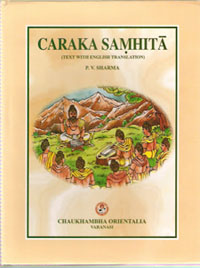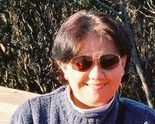

Written by Tel Asiado.
Charaka Samhita is one of the most ancient, comprehensive and authoritative works of ayurveda. It is considered the original reference book of holistic ayurvedic medicine. In Sanskrit, the term "charaka" could also mean a wandering religious student, scholar, or ascetic.

Quotation
"The three—body, mind and soul—are like a tripod, the world stand by their combination; in them everything abides. It is the subject matter of ayurveda for which the teachings of ayurveda have been revealed." ~ Sutrasthana of Charaka Samhita, ayurvedic text. (1.46-47)
"Life (ayu) is the combination (samyoga) of body, senses, mind and reincarnating soul. Ayurveda is the most sacred science of life, beneficial to humans both in this world and the world beyond." ~ Sutrasthana of Charaka Samhita, ayurvedic text. (1.42-43)
Introduction to Ayurveda
Ayurveda is one of the oldest continuously practiced health-care system in the world. It is an ancient Indian healing system. It uses a range of treatments including yoga, massage, acupuncture and herbal medicine to encourage health and well-being. In short, it offers a comprehensive outlook to a healthy life. Derived from its ancient Sanskrit roots - "ayus" (life) and "veda" (knowledge), its origin goes back thousands of years. It signifies the science of life, the origins of most forms of natural and alternative medicine.
Ayurveda in India is mentioned in Rig Veda, one of the oldest (about 6,000 years) philosophical texts in the world. The verses in Rig Veda refer to the five basic elements of the entire creation, with the primary forces of air, fire, water, and earth as comprising the basic principles of Ayurveda as a therapeutic science. The Rig Veda also mentions organ transplants and herbal remedies.
Treatises of Ayurveda
There are three great treatises of Ayurveda, namely: Charaka Samhita, Sushruta Samhita, Vagbhata. Charaka Samhita and Susrutha Samhita are considered its two most important treatises. Compiled during the golden age of Ayurveda and long before the Christian era began, Charaka Samhita concentrates on internal medicine (kayachikitsa), and Susrutha Samhita, on surgery. The third of this great treatise, Vagbhata, emphasizes on treating body physiology and therapeutic use of metals and minerals. While Charaka deals with Self, Vagbhata mentions the body as the home of Self.
Aside from the three great treatises, there are three lesser treatises of Ayurveda: Sharngadhara Samhita, Bhava Prakasha, and Madhava Nidanam. Sharngadhara Samhita enumerates and describes numerous pharmacological formulations and contains the first textual elaboration of diagnosis by means of the pulse; Bhava Prakasha, the most recent of the classical texts, gives the characteristics of many foods, plants, and minerals; and Madhava Nidanam deals with the classification of diseases in Ayurveda. It covers a wide range of diseases including children and women's disorders, although it does not give explanations or suggestions for treatment (chikitsa).
Today, the subject of nutrition is far more complex, and the perception with food as mere calories has changed. In recent years, the holistic wisdom of Ayurveda has gained popularity as an alternative and complement to modern medicine.
Charaka Samhita
The Caraka Saṃhitā ("Compendium of Caraka") is an early Ayurvedic encyclopedia on medicine. Charaka is often transliterated from Sanskrit as Caraka. The "c" was changed to "ch" to aid in the correct pronunciation in these cases. Of the three surviving ancient great treatises of Ayurveda, namely, the Charaka, Sushruta, and Vagbhata, Charaka is believed to be the oldest and the most important ancient authoritative writings on Ayurveda. Along with the Suśruta Saṃhitā ("Compendium of Suśruta"), it is an important source of medical and life understanding and medicine practice in antiquity.
Charaka Samhita explains the logic and philosophy on which this system of medicine is based. According to Charaka, science is dependent upon a quality of the intellect that enables it to perceive phenomena brought into existence by a multiplicity of causes. Much of this treatise is in the form of a symposium wherein groups of Ayurvedic scholars take up a series of topics for discussion. This gives indication that the science of Ayurveda is a product of constant verification, fine-tuning and authentication by an active community of physicians.
It concentrates on the branch or section called kayachikitsa (internal medicine). This is largely the theory of the internal fire or the digestive function of the body - or internal medicine, in modern terms. From a greater perspective, this work represents a certain value of consciousness as it gives notion that life is fundamentally a field of intelligence and pure knowledge. Charaka lays emphasis on health and longevity, to strike a balance between one's corporeal and spiritual being, a reason why it goes detail into the diagnosis of a disease's origin.
Contents of Charaka Samhita
Its language was written in Sanskrit in poetic format, with meter and melody. Poetry was known to serve as a memory aid. The valuable information in this work is scattered over thousands of sutras or verse statements in the manuscript. In ancient times this style helped aspiring students to memorize the sutras. Charaka Samhita's extant text has aṣṭāṅga sthāna (eight sections), totaling 120 chapters containing 8,400 metrical verses, which are often committed to memory by modern medical students of Ayurveda. Seventeen (17) chapters of Cikitsā sthāna and complete Kalpa sthāna and Siddhi sthāna were added later by Dṛiḍhabala (5th century).
The Charaka Samhita starts with Sūtra sthāna which deals with fundamentals and basic principles of Ayurveda medicine practice. Unique scientific contributions credited to the Charaka Saṃhitā include a rational approach to the causation and cure of disease, and introduction of clinical examination's objective methods. The eight chapters are:
- Sūtra sthāna (30 chapters)
- Nidāna sthāna (8 chapters)
- Vimāna sthāna (8 chapters)
- Śārīra sthāna (8 chapters)
- Indriya sthāna (12 chapters)
- Cikitsā sthāna (30 chapters)
- Kalpa sthāna (12 chapters)
- Siddhi sthāna (12 chapters)
Chronology of Charaka Samhita
The detailed biography of the author of this treatise, that is, sage Charaka, is not certain, or, if this represents the work of a "school of thought." Interestingly, it is not an original writing of a single person, rather, like all Vedic knowledge it is a continuation and renewal of that ancient knowledge system. Therefore, it could have come from a group of scholars or followers of a man known as Charaka if not an original composition from a single person named Charaka. In fact, Charaka had redacted the work of Agnivesa Samhita (46,000 version), which is no longer extant. The available form of Charaka Samhita was again worked upon by Dridhabala (living in about 400 AD) long after sage Charaka.
- Originally composed by Agnivesha (Sanskrit: Agniveśa), one of the six students of Atreya.
- Agnivesa Samhita did not survive in its original form.
- Years later Charaka compiled and revised the brief sutra style of Agnivesha’s work with annotations and interpretations. His contributions in this respect were so remarkable that the original treatise in its new form began to be known as the work of Charaka.
- Centuries later, the latter one third of the Charaka Samhita is believed to have been compiled by another physician Dridhabala (or Drbhabala) who also revised portions written by Charaka.
- The name of the compendium remains as Charaka Samhita.
For practical purposes, Charaka’s compendium represents Atreya’s system of medicine as handed down by his student Agnivesha. Passages on the qualitative and quantitative aspects of food in Charaka Samhita are contained in the earlier portions composed by Charaka.
Conclusion
The popularity and continuity of Ayurveda tradition lies in its approach to heal a person in its totality - the healing the body, mind and spirit - all in one go. Its unique understanding of the similarities of natural law and the working of the human body, as well as its holistic treatment methods, help it to strike a balance between the two.
Charaka followed the Atreya School of Physicians, which predominantly deals with treatments through internal and external application of medicine. Its focus is on healing the body, mind and soul of a patient in a minimally invasive manner, hence, the placed emphasis on the diagnostic part of the treatment, as well as on the timing and manner of the collection of medicinal plants.
Like the other treatises of Ayurveda, Charaka Samhita has different translations. The P.V. Sharma translation comes in four volumes, two of original text and two of commentary about the original work. Sharma's English version is said to be a scholarly and relatively faithful work, with numerous appendices and an extensive index. The B. Dash / R.K. Sharma version lacks these features but does have extensive commentary incorporated in with the original text.
Resources
- Dick, Michael, MS. and The Ayurvedic Institute (1998). The Ancient Ayurvedic Writings. Accessed May 14, 2013.
- Life Positive. History of Ayurveda in India. Accessed May 14, 2013.
- Peppertrain. Charaka Samhita - A Brief Introduction. Accessed May 14, 2013.
- Tiwari, Lalit. "A Summary of the Late D. Chattopadhyaya's Critique of Charaka Saṃhitā." Accessed May 14, 2013.A cite of D. Chattopadhyāya (1982). Case for a critical analysis of the Charak Saṃhitā In Studies in the History of Science in India (Ed. D. Chattopadhyāya). Vol. 1. New Delhi: Editorial Enterprises. Pp. 209-236.)

About the Author
Tel Asiado is a writer, author, content producer, and business consultant. She owns various niche websites. Her articles reflect her passions in writing & reading, biographies & histories, inventions & discoveries, to classical music, art & literature and small business. Tel has produced non-fictions, e-books and anthologies, and has written numerous articles on varied subjects online and in print. Her education is MBA, BScience in Chemistry, and Diploma in Small Business & Internet Mktg.
Winter Survival Food Handbook

PDF Plant Magazines
Types of Wild Food
Geographic Zones Seasons
Disclaimer
EdibleWildFood.com is informational in nature. While we strive to be 100% accurate, it is solely up to the reader to ensure proper plant identification. Some wild plants are poisonous or can have serious adverse health effects.
We are not health professionals, medical doctors, nor are we nutritionists. It is up to the reader to verify nutritional information and health benefits with qualified professionals for all edible plants listed in this web site. Please click here for more information.
Why Edible Wild Food?
- Food costs are rising
- Free, wild food is readily abundant
- Wild food adds nutrition to your diet
- Wild food can help treat various medical conditions





